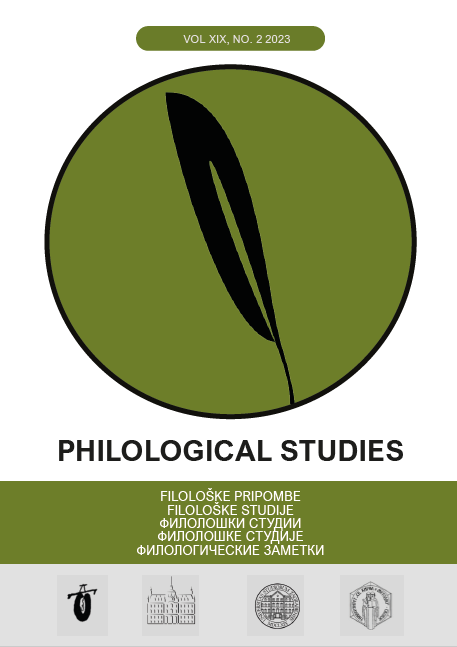THE SEMIOTIC LANGUAGE OF SIGNS AND SYMBOLS IN VISUAL FOLKLORE NARRATIVES – ANALYZES AND OBSERVATIONS
Abstract
This paper looks whether the key terms of the representational - syntactic and pragmatic categories can also be applied in the study of traditional visual narratives, as a sign system with certain symbolic messages. We believe that the answer to this question fully corresponds to the basic postulates and methods of semiology, as a science of the study of signs and the symbols and the mutual relations that they establish, i.e. bearers of the sign and the signified (designatuma/ denotatuma), where each individual object can imply certain signs. In the context of this, we showcase several examples of embroidery, a selection from Macedonian folk costumes, which we believe correspond visually and semiologically with Jung's mandalas. They are presented in this text as images with certain symbolic values, which speaks in favor of the power of the collective memory of a nation, group or community that consciously or subconsciously integrated its spiritual, aesthetic and cultural values into its collective consciousness. This phenomenon indicates that this is an archaic cultural matrix, close to the ontological, universal values of man in a wider cultural, temporal and areal context. Hence, we consider that the polystadiality of folklore, which contains different layers of mythology, history and tradition of a given community, is not only characteristic of different literary-narrative folklore forms, but is also applicable in the study of "visual narratives" (decorative patterns, motifs and ornaments), represented in the traditional material culture of peoples around the world.
Downloads
References
Drofles, Gillo. (1965) Pouroucontrel`estetique structuraliste, Revue international de philosophie, t. XIX, No.73-74, 409-441, Bruxelles.
Eko, Umberto. (1973) Kultura, informacija, komunikacija. [Culture, information, communication] Beograd: Nolit. (in Serbian)
Giro, Pjer. (1975)Semiologija,[Semiology], Belgrade publishing house, Beograd: Beogradskiizdavacko-grafickizavod. (in Serbian)
Hall, Manly P. (1928) The secret teachings of all ages, San Francisco: by H.S.Crocker com.
Jung, Carl G. (2017) Mandala Symbolism: Vol. 9i, collected Works, Vol., Princenton : Princeton Legacy Library.
Jung, Carl G. (1968) Man and His Symbols, Part I. The Importance of Dreams, New York :Anchor press.
Jung, Carl G. (1984) Psihoanaliza i alhemija [Psychoanalysis and alchemy,] Zagreb: Napred.
Kovačevič I., (1985) Semiologija rituala, [Semiology of rituals], Beograd:Prosveta.
Rudolf, Carnap.(1942) Introducion to Semantics. Cambridge: Harvard University Press.
Rudolf, Carnap (1947) Meaning and necessity: a Study in Semantics and Modal Logic, Chicago : University Chicago Press.
De Saussure, Ferdinand. (1916) Cours de linguistique générale, publié par Charles Bally, Albert Sechehayeet de Albert Riedlinger. Lausanne, Paris.
Wilhelm, Richardand Jung, Carl Gustav (1947) -translated and explained, The secret of the golden flower a Chinese book of life, London: Lund Humphries.
Барт,Ролан. (1971) Елементи семиологије, во: Књижевност, митологија, семиологија. Београд : Нолит. [Bart, Rolan. (1971) Elements of semiology, in: Literature, mythology, semiology. Belgrade: Nolit]. (in Serbian)
Ворингер, В. (1993) Абстракция и вчувствуване, София. [Voringer, V. (1993) Abstraction and Feeling, Sofia]. (In Bulgarian)
Јунг, КарлГустав. (2020) Спомени, соништа и размислувања, Скопје: КЦС/Полица. [Jung, Carl Gustav. (2020) Memories, dreams and reflections, Skopje: KCS/Polica.] (in Macedonian)
Леви-Строс, Клод (1971) Структура митова - Мит, Традиција, Савременост, Београд: Дело. [Levi-Stros, Klod (1971) The structure of myths - Myth, tradition, modernity, Beograd : Delo]. (in Serbian)
Лотман, Ю.М.(1987) Несколькомыслей о типологии кулътур, Язики культуры и проблеми переводимости, Москва, 5-37. [Lotman, Y.М (1987) Some thoughts on the typology of cultures, Languages of culture and problems of translatability, Moscow, 5-37]. (in Russian)
Мeлетински, J. M. (1975) Структурна типологија и фолкор, Народно стваралаштво фолклор, год. XIV, св. 53-56, Београд : Научно дело, 88-104. [Meletinsky, J. M. (1975) Structural typology and folklore, Folk-crafted folklore, yr. XIV, book. 53-56, Beograd: Naučno delo, 88-104.] (in Serbian)
Обрембски, Јозеф. (2003)Порече 1932 -1933, Скопје : Матица Македонска. [Obrembski, Josef. (2003) Poreče 1932 -1933, Skopje: Matica Makedonska]. (in Macedonian)
Ристовска Пиличкова, Јасминка. (2021) Симболиката на зооморфните мотиви во македонската традиционална текстилна орнаментика, Скопје: Институт за фолклор „Марко Цепенков“, Скопје. [Ristovska Pilichkova, Jasminka. (2021) The symbolism of zoomorphic motifs in Macedonian traditional textile ornamentation, Institute of folklore "Marko Cepenkov", Skopje]. (in Macedonian)
Ристовска Пиличкова, Јасминка. (2015) Лазарските обредни форми и дејствија, извор на женската пубертетска иницијација на премин - низ примери од македонскиот фолклор, Philological Studies, 13(1), Скопје, 35-50. [Ristovska Pilichkova, Jasminka. (2015) Lazar ritual forms and actions, source of female puberty in itiation of transition – through examples from Macedonian folklore, Philological Studies, 13(1), Skopje, 35-50.] (in Macedonian)
Тресидер Џек (2001) Речник на симболи, види: мандала, 148-149. Скопје : ТРИ. [Tressider Jack (2001) Dictionary of Symbols, see: mandala, 148-149. Skopje: THREE] (in Macedonian).
АИФ – Архива на Институтот за фолклор „Марко Цепенков“ - Скопје.
Downloads
Published
Issue
Section
License
Philological studies © 2019. This work is licensed under a Creative Commons Attribution-Noncommercial-No Derivative Works 3.0 Unported License


